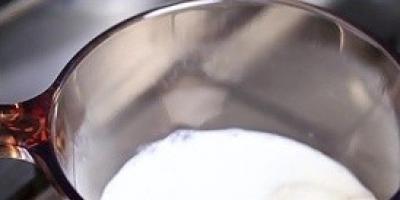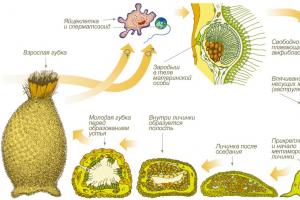Sarah Bernard's colorful peony bush gives any sunny corner of the garden the feeling of a luxurious holiday. Strong stems do not bend to the ground, but hold large baskets of a delicate pastel pink shade almost vertically, allowing you to admire them for a long time lush flowering.
Description
Peony Sarah Bernhardt was developed at the beginning of the twentieth century by the French gardener Pierre Lemoine, naming it in honor of the talented actress. Soon, scientists from Moscow University adapted the peony to the conditions of Russia. Possessing high level decorative, the variety received awards at exhibitions and became the standard of its type.
Hybrid Sarah Bernhardt blooms profusely and for a long time - from a week to three, but later than other peonies. The bush, 0.9-1 m high, produces single baskets with a delicate aroma on a strong peduncle. Large inflorescences are semi-double or double, pink or spherical. Lush flower– 16-20 cm in diameter, individual specimens – up to 25 cm. The petals are slightly concave towards the center of the flower. The coloring of the petals changes depending on the lighting and duration of flowering: from light pink tones to crimson or lilac. The originality of the flowers is emphasized by the characteristic silver-white border of each petal.
Peony Sarah Bernhardt
Based on the hybrid, varieties with white, red, yellow and cream colors have been bred and distributed. Peonies White Sarah Bernhardt and Sarah Bernhardt Red are also late bloomers. Bushes of derived forms are lower - up to 85 cm, the size of flowers is also smaller - up to 15-17 cm.
Peonies retain their spectacular appearance throughout warm season, thanks to the dense dark green leaves that acquire a dark purple color in the fall. The foliage of the Sarah Bernhardt hybrid becomes green already in April and does not turn yellow in the summer.
Important! The stems of the hybrid are resistant to lodging.
Agricultural technology
Landing
The peony bush, which is unpretentious in care, is demanding only at the time of transplantation. The decorativeness of the plant depends on the choice of place and time.
Time
Flower growers plant peonies from the end of August to the third ten days of September. New bushes bloom in two years.
Planting peonies
The best soil for milky-flowered peony is loam with low acidity:
- in areas with acidic soil, where the pH reaction is below 5-6, preliminary liming of the substrate for the planting pit is carried out, adding per 1 square meter. m of soil 450-500 g slaked lime or 200-300 g dolomite flour;
- half the volume of clay is added to the sandy loam soil;
- sand is mixed into clay soil;
- good drainage and loose soil are important for rhizomes.
Additional Information. After liming, the substrate is enriched with humus.
Peonies develop well in sunny, cozy place, light partial shade is allowed during lunch hours. Peaty, dry, sandy areas or those where groundwater approach at a distance of 1 m to the surface. Peonies planted in the shade will not bloom.
Seedling preparation
Elastic divisions of peony rhizomes with 2-3 buds are disinfected in a solution of potassium permanganate or in garlic infusion for 15-20 minutes. Then the seedlings are placed in the selected growth stimulator, according to the instructions for the drug. Dried planting material The cuts are treated with additional wood ash and planted.
Planting process
It is better to dig a spacious hole for the powerful Sarah Bernhardt bush a month before planting. The size of the pit is 60x60 cm, with the same depth. Place drainage and prepare the substrate. For fertilizer, take 500 g of bone meal, 200 g of superphosphate, a liter jar wood ash.
Peony seedlings
Follow the landing algorithm:
- The rhizome is placed on the prepared substrate in such a way that the buds are not buried more than 5 cm from the ground level;
- Sprinkle with soil, lightly compacting;
- Water with 5-6 liters of water;
- The entire surface of the hole is mulched with peat, humus or plant debris, which is removed in the spring.
Advice. The interval between peony bushes is 1 m.
Care
The unassuming peony Sarah Bernhardt develops well with minimal care. In a well-chosen location, the plant will bloom for 30-80 years.
Top dressing
The first two years the bush uses a set of fertilizers contained in landing hole. In the third year, peonies are fed:
- in early April, after the snow melts;
- in the phase of bud formation;
- two weeks after flowering.
Increasingly they use convenient integrated mineral fertilizers for flowers, following the attached instructions. In the spring, up to 0.5 liters of wood ash are also placed under the bush, sprinkled lightly with earth. In the summer, at the beginning of July, it is justified to introduce a solution of mullein or chicken droppings. Organic matter is diluted in proportions of 1:5 and 1:15, respectively.
Top dressing
At the end of August, a solution of superphosphate is poured under the peony: 30 g per bucket of water. First, the granules are dissolved in a liter hot water, leaving for a day and stirring from time to time. Then combine with the rest of the liquid.
Loosening, mulching
After watering, the soil is carefully, not deeply loosened. Lay dry grass as mulch to retain moisture.
Drafts
Windy areas quickly reduce the decorative value of the bushes, knocking off the delicate petals. But the strong flower stalks, according to the description, withstand gusts without falling to the ground.
Watering
Peonies are quite drought-resistant. In spring and early summer, the bushes need abundant weekly watering - 20-40 liters for an adult plant. Later, water at the same rate twice a month if there is no precipitation. In the first ten days of August, watering is resumed, as flower buds for the next year are being laid.
Irrigation and spraying
It is better to irrigate peonies in the evening to avoid sunburn on a clear day. Sprinkling the Sarah Bernhardt peony bush with a fine spray will help maintain its vibrant beauty in dry weather.
Pest treatment
Dampness, like pests, can cause fungal and viral infections. Fungicides will help protect flowers from fungal diseases. Viral mosaics often lead to the death of bushes. Usually such plants are destroyed.
Bouquet Sarah Bernhardt
Peonies preventively protect against diseases and pests in early spring, spraying the bush with three liters of Bordeaux mixture. At the same time, soil disinfection occurs. Gardeners mainly collect bronze flowers from flowers by hand. Aphids are eliminated by using insecticides or soap solution. They also monitor the development of ant families and divert this threat from the bush by moving the anthill or using poisonous traps.
You should avoid planting peonies near raspberries, strawberries, tomatoes, potatoes and cucumbers, which may suffer from viral infections.
Replanting, pruning
It is useless to replant an old peony bush without dividing the rhizome. In a new place, the plant usually withers. It needs stress due to damage to the roots, which will stimulate the formation of new stems and further development.
Transplanting peonies
An important point in caring for peonies is the removal of faded heads, which can become a source of fungal infections. In September-October, the stems are cut to a height of 10-15 cm. They can be used to cover bushes during the cold period.
Wintering
In autumn, peonies are mulched with compost or humus, in a layer of up to 3-5 cm. Then the trimmed bushes are covered with the remains of old stems. Rhizomes winter well under snow. No additional shelter made from scrap materials is required.
Reproduction
Herbaceous peonies, like the Sarah Bernhardt hybrid, are easier to propagate by dividing the rhizomes in early autumn. Experts take cuttings or develop strong stems for sprouts.
Growing peonies
Application in landscape design
Peonies are expressive soloists; group plantings of single-colored or different-colored varieties also look beautiful. In spring, against the background of their dark foliage, bright bulbous ones win. In the summer, petunias, lilies, geraniums, and phlox become partners of peonies, and in the fall - asters and chrysanthemums.
Sarah Bernhardt flowers create an attractive fragrant bouquet; on the garden lawn they will become an attractive island for relaxation.
This type of peony was bred more than 100 years ago, but it is still considered one of the most beautiful, expressive and aromatic varieties. His name was given by the famous breeder Pierre Lemoine, who was a contemporary of the great French actress and was delighted with her creativity, style of acting, feminine charm and human wisdom.
Peony "Sarah Bernhardt" - description
The famous critic Stanislavsky was sure that the work of Sarah Bernhardt is the standard of stage acting. Lemoine endowed the bred flower with the same perfection. First of all, this peony is known for its rich color palette:
- white peony "Sarah Bernhardt" looks like an airy meringue or a cloud with rounded cut petals;
- the red peony "Sarah Bernhardt", like a burning heart, attracts glances and bursts with passion;
- The milky-flowered peony "Sarah Bernhardt" is associated with tenderness and love, youth and summer.
The flowers of this peony variety have other tones and shades - they are multifaceted and unusual, unlike traditional varieties. In addition, "Sarah Bernhardt" blooms profusely - the rounded cap can be recognized even in a garden with numerous types of peonies. The flowers of this variety are semi-double, reaching a diameter of 20 cm. They are held on strong, not very tall stems, so the bushes usually look very neat and do not fall to the ground under the weight of the inflorescences. The openwork leaves of the peony variety "Sarah Bernhardt" begin to turn green in April and retain their succulent appearance until autumn.
How to care for the herbaceous peony "Sarah Bernhardt"?
Peonies are recognized quite unpretentious plants: in one place they can grow well and delight with flowering for more than 30 years. There are even cases of longevity when the flower was not replanted and it produced wonderful flowers and greenery for more than 80 years.
But for good growth peony, certain conditions must be met:
- Particular attention must be paid to the soil - it should be clay or loamy. Before planting, it is recommended to fertilize it with nutrients. The plant will die on wetlands; in sandy areas they dry out and age quickly; they also do not like peat.
- It is better to plant peonies in sunny, windless areas, not covered by trees or buildings.
- Since the peony has large roots, the planting hole should be large and deep. Experts advise pouring drainage and a mixture of soil with manure, compost, etc. into the bottom of the hole a few weeks before planting.
- The depth at which peonies are planted directly affects their flowering. It is important not to bury the kidneys.
Peonies do not require special care; they tolerate frost well and lack of annual fertilizers. At the end of September, the peony leaves are cut off and the plant survives the winter well.
Transplanting the peony "Sarah Bernhardt"
You don't have to wait long for flowers after transplanting. Already in the 2nd year you can see extraordinary buds. To propagate peonies, division of rhizomes is used, which is carried out in August-September  . For the winter, young plants must be trimmed and covered with peat or. In the spring, you just need to remove the “cover” and within a couple of weeks the greenish shoots will reach for the sun.
. For the winter, young plants must be trimmed and covered with peat or. In the spring, you just need to remove the “cover” and within a couple of weeks the greenish shoots will reach for the sun.
Sarah Bernhardt could unsurpassably play even the subtle shades of human emotions and feelings - the peony variety of the same name is just as bewitching, exquisite and impeccable. Few people can indifferently pass by the magnificently blooming “Sarah Bernhardt” peony bush. By the way, it blooms in the mid-late period, when many varieties have already faded and looks royal on summer cottages, in flower beds. Bouquets with this flower are also beautifully formed and last a long time.
Among the huge variety of flowers that grow near cottages and private houses, you should pay special attention to peonies. They have become widespread due to their unpretentiousness, longevity and, of course, the beauty of flowering. Today, more than 5 thousand varieties of peonies have been bred, each of which impresses with its brightness and originality. The Sarah Bernhardt peony, named after the talented French actress, deserves special attention. Numerous photos of this herbaceous perennial are evidence of its amazing charm.
The history of the peony Sarah Bernhardt and its modern forms
This hybrid was created by the famous breeder Victor Lemoine, whose creations included numerous varieties of not only peonies, but also lilacs. History is silent about why the breeder named it in honor of the celebrity. One can only assume that Victor Lemoine was so delighted with the talent and beauty of her countrywoman that he decided to dedicate one of his best varieties to her.
The flower named after the actress is considered a standard of gardening skill. The late-ripening variety of peonies even received an honorary English AGM award, awarded by the Royal Horticultural Society.
Main characteristics of peony Sarah Bernhardt:
- petals - dark crimson, double or semi-double;
- bud diameter – 15-20 cm;
- bush height – 80-90 cm;
- aroma – strong and rich;
- leaves – openwork, dark green;
- Flowering duration is 1-1.5 months.

Flowering variety Sarah Bernhardt
Today you can find other, more modern varieties of the named variety. Thus, peonies of red, pearl pink and muted lilac colors were bred.
A spectacular milky-white flower has become widespread. It is distinguished by its pink shape and rounded petals with a silver border. Two or three buds may appear on one stem at once. The value of this variety lies in its resistance to diseases and frosts.
Rules for planting and propagation
A peony can grow even without careful care for up to 30 years. To achieve the greatest decorative effect of a flower, it should be planted against the backdrop of a well-groomed lawn or made part of a constantly blooming garden.
Lighting and soil requirements
Peonies grow best in well-lit areas of the ground, where light shade falls no earlier than noon. In the shade, the flower will not be able to produce buds, although it will not die.
The best soils for these flowers are considered to be loams that have only a slightly acidic reaction. If planting is planned on clay soil, then it is worth adding sand to it. Soil with a high pH needs to be limed to obtain optimal acidity (300 g / 1 sq. m).
Attention! Peonies will not bloom well in soils that are too acidic or waterlogged.
Reproduction
The described flowers are often propagated by dividing the bush, which is done in August or September. In this case, you need to follow these instructions:

- dig up a bush;
- cut 10 cm from the root;
- wash the roots running water, then dry and germinate in a dark place;
- choose planting material with a sufficiently large root (10-15 cm) and two or three buds;
- disinfect the “delenka” by placing it for 30 minutes in a solution of potassium permanganate or garlic composition;
- keep the planting material for half a day in the Heteroauxin solution (dissolve one tablet in 10 liters of water);
- dry the “cut” and cover all cuts with charcoal.
Planting seedlings
When disembarking or transferring to permanent place, you need to maintain a distance of one meter between bushes and adhere to the following rules:
- prepare a fairly large hole (60x60x60 cm);
- fill it with a mixture of humus, earth, sand and peat;
- add fertilizer: 0.2-0.4 kg of superphosphate, 0.5 kg of bone meal, 1 tbsp. spoon iron sulfate, 1 liter of wood ash and 1 teaspoon of potash;
- fill the hole with garden soil;
- compact it a little and water the planting.
Attention! Don't expect flowering this same year. The first buds will most likely appear only next year.
How to properly care for peonies
These unpretentious flowers require minimal care:

- During the period of bud setting and flowering, peonies need to be watered in the evening once every 7 days (2-4 buckets per bush).
- After correct landing Peonies do not need feeding for several years. Then you should apply fertilizer three times a year. In the spring, you can mulch the soil with peat and add a little wood ash; in June, water the flower with the solution bird droppings, and in the fall - fertilize with superphosphate (1 tablespoon per bucket of water).
- Periodically remove weeds around the bushes, loosen the soil after watering, remove dried inflorescences, and trim the stems for the winter.
Attention! Faded inflorescences must be removed on time, otherwise they can cause the flower to become infected with a fungus.
Sometimes peonies suffer from the following diseases:
- Gray rot - has the appearance of a gray coating, most often affecting young bushes. To avoid this disease, you need to treat the bushes and soil in early spring. garlic solution or Bordeaux mixture.
- Rust - appears as brown spots on the leaves. To prevent the disease from spreading, you need to trim and burn all affected peony leaves.
- Mosaic - has the appearance of yellow stripes and light green spots on the leaves of peonies. This virus has no cure and requires complete removal and burning of the bush.
Therefore, the Sarah Bernhardt peony is a luxurious flower that can decorate any yard or garden. If you adhere to the rules of planting and care, then every year it will delight the owners of the house with colorful and long-lasting flowering.
Variety Sarah Bernhardt: video
The gods themselves patronize. Among the huge number of garden plants, these spectacular and unpretentious flowers deserve special attention.
Today, more than 5 thousand varieties of this crop have been bred, but among them, the Sarah Bernhardt peony, named after the talented French actress, especially stands out. Despite its hundred-year history, this fragrant flower never ceases to delight the eye with its lush blooms and deep colors.
The history of the peony Sarah Bernhardt
This hybrid gained popularity more than a century ago thanks to the efforts of the famous breeder Pierre Lemoine. History is silent about why this magnificent flower was named in honor of Sarah Bernhardt.
It is assumed that the breeder lived at the same time as the well-known actress and was her devoted fan. The variety has absorbed the most best qualities this brilliant woman: aristocracy, charm, sophistication and grace.
Sarah Bernhardt was a famous French actress, and many film fans to this day consider her one of the most talented actresses in cinema. She was born in October 1844 in Paris. In the 1870s she received universal recognition in Europe, after which she successfully toured in America.
Sarah Bernhardt's repertoire includes mainly dramatic roles, sensual and soulful, which is why she was called the “Divine Sarah.” At the beginning of the 20th century, the actress was called the most famous in history. It is noteworthy that not only the peony was named in honor of Sarah Bernhardt, but also the Bernard crater on the planet Venus.

The peony variety was named after the famous actress Sarah Bernhardt.
Interesting. For its outstanding decorative characteristics and garden qualities, the Sarah Bernhardt peony variety was awarded the English AGM Award of Garden Merit of the Royal Horticultural Society (RHS), awarded annually by the Royal Horticultural Society.
The variety came to Russia almost immediately after breeding. Its dissemination and popularization were carried out by the peony growers of the Moscow state university named after M.V. Lomonosov (MSU). The plant did not immediately become known as the Sarah Bernhardt peony, at first it was called Miss Eckhart or Alex Fleming. And only later the error was corrected, and the flower acquired its original name.
Description and botanical characteristics of peony Sarah Bernhardt with photo
The detailed description and available photos suggest that the representatives of the variety are multifaceted and unusual. It is a late ripening plant because the flowers begin to appear at a time when most varieties have already stopped flowering.
The flowering period lasts from a month to a month and a half. Hybrid is different abundant flowering: A lush cap can be easily seen in a garden with numerous types of peonies.










The main characteristics of the Sarah Bernhardt variety include:
- massive single buds with a diameter of 15-20 cm;
- double or semi-double petals of concave type;
- long strong stems reaching a height of 1 meter and resistant to lodging;
- openwork dark green foliage of dissected shape, which begins to turn green in April and retains its rich appearance until autumn;
- bright juicy aroma.
Light pink color with a silver edge is characteristic of this variety. But today in gardens and gardens you can find specimens of red, pearl pink, white, yellow, muted lilac and cream.
A special feature of peony is the absence of yellowed leaves: during the summer, the plant is dressed in a rich green outfit, which turns purple by autumn. The bush does not need support and retains its shape perfectly, does not fall apart in different directions and does not sag towards the ground. Tolerates winter frosts with dignity and requires only autumn pruning foliage.
Rules for planting and growing
Without proper care, peonies can grow in one place for 30 or even 50 years. This variety is hardy and undemanding, but for high-quality flowering, certain planting and cultivation rules should not be neglected.

Sarah Bernhardt peonies are unpretentious and can grow in one place for up to 50 years.
Selecting a location
Peony is a light-loving plant, so the optimal place for planting is considered to be a well-lit area with little shade in the afternoon. A bush planted in the shade will not die, but will no longer please with beautiful flowers.
Soil preparation
The best soil for growing is loamy with a slightly acidic reaction. If clay predominates in the soil, then it should be diluted with sand, and vice versa. In soil with a high degree of hydrogen index (pH) before the procedure, it is necessary to add lime until optimal indicator acidity – 300-350 g/1 sq. m.
Important. For growing peonies of this variety, damp, swampy, excessively acidic soil, as well as soil with close concentrations of groundwater, are unacceptable.
Planting peonies
Planting peonies by Sarah Bernhardt has some nuances. For example, a powerful root system of a plant requires a large and deep planting hole. A few weeks before planting, the bottom of the hole is lined with drainage, and the top is filled with a mixture of ash, manure and compost. Planting, as well as transplanting, is carried out only in autumn.
Planting scheme

Before planting peonies, deep holes should be prepared.
The procedure for planting a plant begins with the selection of a division. The best option a sample with 2-3 buds and a root 10-15 cm long is considered. Before moving it into the ground, it is disinfected in a weak solution of potassium permanganate or garlic composition for 30 minutes.
After this, they are placed in the Heteroauxin preparation for 12 hours. After this time, the planting material is removed, thoroughly dried, and the cut areas are treated with charcoal.
The direct planting process comes down to several steps:
- The bottom of the planting hole is treated with sand, after which planting material is placed into it. In this case, it is important that the gap from the ground to the buds is no more than 5 cm: too strong or, conversely, weak recess will lead to poor flowering or its absence at all.
- The delenka is sprinkled with earth and watered thoroughly.
- For easy wintering, the plant is mulched with a peat layer 5-7 cm thick. In the spring, when red sprouts appear and rise slightly, the mulch is removed.
The distance between planting holes should be at least 1 meter, since peony bushes grow on a large scale. When transplanting to a permanent place, the hole should have the shape of a cube 60x60x60 cm, and be more than half filled with a mixture of peat, sand, earth and humus (in equal parts).
The pit is fertilized with a composition of:
- bone meal – 0.5 kg;
- double superphosphate – 0.4 kg;
- wood ash – 1 l;
- iron sulfate - 1 tbsp. spoon;
- potassium carbonate – 1 teaspoon.
The voids of the pit are filled with garden soil, after which the planting is slightly compacted and well moistened. After transplantation, the first flowers appear after two years.

The holes with seedlings are filled with earth, and fertilizer is first poured onto the bottom.
Spring, summer and winter plant care
In the summer, no more than half of the peduncles thrown out by it are left on the bush. In June, the plants must be watered with a mixture of bird droppings. Weeds are systematically removed around the bushes, after watering the earth is loosened, and dried inflorescences are removed.
Attention. Faded inflorescences must be removed in a timely manner, otherwise there is a risk of the plant becoming infected with fungal diseases.
In mid-autumn, usually in the second half of October, the stems are pruned. After cutting, stumps of about 1-2 cm should remain above the buds.
IN winter time the plant feels comfortable and does not need shelter. The Sarah Bernhardt variety tolerates severe Russian frosts well. But it never hurts to be on the safe side, so it is advisable to cover the bush with immature compost or a layer of peat for the winter.
In the spring, when the soil begins to thaw, the covering material is immediately removed from the plant. This way the buds will begin to germinate faster. During the period of bud setting and flowering, peony bushes are watered once every 7 days in the evening, in the amount of 2-4 buckets per bush. In spring, the soil is mulched with peat with the addition of wood ash.
Feeding and fertilizers

Sarah Bernhardt peonies must be fed.
They are of great importance for the harmonious growth and development of plants. Mineral fertilizers applied to the planting hole will provide the plant with all the necessary nutrients for the next 3-4 years. Later they need to be fed from time to time.
For optimal development of the root system, potassium-phosphorus fertilizers will be required, and nitrogen fertilizers will be required for active bud formation.
The peony variety Sarah Bernhardt requires 3-stage feeding in the spring-summer period:
- The first is carried out in early spring, when there is still snow. A mixture of urea and potassium sulfate in a ratio of 15 g x 15 g is scattered around the circumference of the bush.
- The second one is needed for planting flowers. For these purposes, a solution of 10 g of urea, 15 g of potassium sulfate and 20 g of superphosphate is used.
- The third and final fertilizing is done at the end of flowering to stimulate bud growth. The composition includes potassium and phosphorus fertilizers in equal proportions (15 g each).
You cannot fertilize when the soil is dry: this can cause burns to the root system and further death of the plant. Manipulations are carried out only after watering or rain.
The optimal way to moisten the soil for Sarah Bernhardt peonies is abundant, but not frequent watering. In hot weather, shrubs are irrigated approximately once every 10 days, not more often. When carrying out the moistening procedure, you need to know that each adult bush needs 30 liters of water.
An increased need for fluid occurs during the phase active growth, budding and flowering. In July-August, when buds begin to form, the plant especially needs regular moisture.

Peonies of the Sarah Bernhardt variety need to be watered abundantly: up to 30 liters per bush.
The best time to water is early morning or evening, when exposure to the sun is minimized. The first watering is carried out some time after the soil has thawed. In order for the shrub to gain maximum benefit, it is recommended to use a solution of potassium permanganate (2-3 g per bucket of water) for moisturizing.
Peony propagation Sarah Bernhardt
Peonies of this variety are most often propagated by cuttings, layering and division of rhizomes. The last option is the simplest and no less effective. The procedure is carried out only when the plant has gained strength and power, and this is approximately 3-4 years after planting. The operation to separate the roots is performed no earlier than August-September.
Some gardeners prefer planting seeds and growing the crop themselves until transplanted to a permanent location. However, the disadvantage of this method is the slow growth of seedlings.
Susceptibility to diseases and pests
Peonies are on par with others garden plants are susceptible to certain diseases:
- Gray rot. This disease mainly affects young shrubs and manifests itself as a gray coating on leaves, stems and flowers. For prevention of this disease in early spring, the plant is treated with Bordeaux mixture (3 liters per bush) or garlic solution (1 ground head per 2 liters of water).
- Rust. The most dangerous disease, manifested by brown spots on the leaves. In this case, all affected parts are cut off and burned.
- Ring mosaic. This viral disease is characterized by yellow and light green stripes on the leaves of peonies. It cannot be treated and requires the elimination of the bush in the form of removal and burning.

Peonies of the Sarah Bernhardt variety are susceptible to gray rot and other fungal diseases.
Care after flowering and preparing the plant for cold weather
After flowering ends, caring for peonies does not stop. In order to enjoy lush, rich blooms next year, you need to properly prepare them for winter. First of all, all weeds are removed and the soil is thoroughly loosened. Faded buds are removed and the stems are trimmed. The operation is carried out quite low, leaving only small stumps.
At the end of September, the bushes are sprinkled with compost to protect them from the cold, and in more serious cases (when the winter is extremely severe), you can use spruce branches. Such shelter will be especially useful for young seedlings.
Modern forms of peony Sarah Bernhardt
Among modern varieties This peony can be distinguished by the popular milky white peony Sarah Bernhardt White with a soft silver border. Its flowers have a pink shape, buds with rounded petals.
The diameter of the flowers is on average from 15 to 17 cm, and the bushes themselves grow up to 80-90 cm. The size of the leaves is moderate, the color is dark green. White peony Sarah Bernhardt is a frost-resistant plant with low sensitivity to diseases.

Breeders bred the new kind Peony - Sarah Bernhardt White.
In addition to snow-white peonies, red, pearl pink and muted lilac varieties were bred based on the Sarah Bernhardt variety. Among them, Sarah Bernhardt Red stands out, delighting with the beauty of its bright crimson-red flowers. Their diameter is about 15 cm, the height of the shrub does not exceed 85 cm. The leaves are openwork, dark green in color. Refers to mid-late flowering plants.
Peonies Sarah Bernhardt in landscape design
Peonies of this variety are in excellent harmony with other plants and can decorate parks, landscapes, personal plots, garden areas and rock gardens.
In most cases, the compatibility of peonies with other colors is determined by the available color palette. Thus, white representatives of the variety look great against the background of irises, bells, poppies, daylilies, honeysuckle and sage. The grace and grandeur of red peonies are effectively emphasized by decorative onions, and pink representatives of Sarah Bernhardt - by barberry bushes, hellebores or graceful thuja.
In the video, the gardener shows how to properly plant the rhizome of the Sarah Bernhardt peony in a pot.
Peony herbaceous Sarah Bernhardt is a subshrub, beautifully flowering perennial, intended for creating landscape gardening landscape decorations. The bushes are tall - more than 1 m, spreading, with carved dark green foliage. The buds are single, ripen at the tops of the shoots. Blooms in July, fades in August or September. The flowers are double and semi-double in a rich pink hue.
Reproduction of peonies by dividing the bush
In the fall, the bush is carefully dug up and divided so that 3-5 new buds are on top of the rhizomes. The plant is washed, the roots are soaked in a solution of potassium permanganate, then sprinkled with charcoal or ash and placed in a moist, loose environment for 24 hours. For better survival, before planting, rhizomes are treated with biostimulants - root, epin or heteroauxin (proportion - 5 g per 10 l).
Grace and laconicism of peony Sarah Bernhardt
- Rich and seasoned shades.
- Late dissolution, long flowering.
- Lush bud shapes.
- Openwork foliage of dense bushes.








